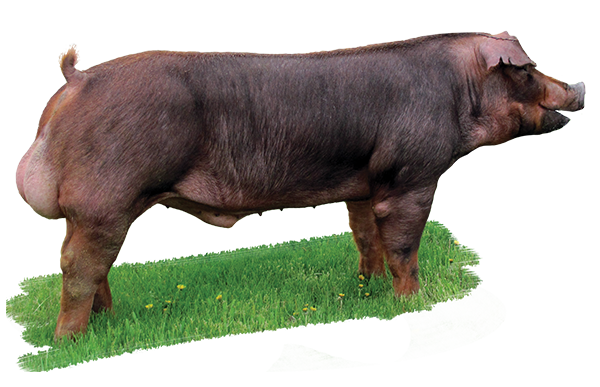
Duroc sires are utilized most frequently as a Terminal/Paternal sire in a terminal cross-breeding program. They sire market pigs that excel in durability, growth, and muscle qualities attributes, and are competitive with other industry sires for carcass leanness and feed efficiency. Duroc boars are the predominate Terminal sire used in the world and provide 100% heterosis when mated to Yorkshire x Landrace F1 females. Some systems utilize a commercial parent stock female that is 25% Duroc to improve robustness and longevity in their sow herds.
Updated by the board of directors of the United Duroc Swine Registry – March, 2015
For a printable version of these requirements click the button below:
Durocs are red pigs with drooping ears. They are the second most recorded breed of swine in the United States and a major breed in many other countries, especially as a terminal sire or in hybrids. Durocs can range from a very light golden, almost yellow color, to a very dark red color that approaches mahogany.
In 1812, early "Red Hogs" were bred in New York and New Jersey. They were large in size. Large litters and the ability to gain quickly were characteristics Durocs possessed from the beginning. The foundation that formed today's "Duroc" was comprised of Red Durocs from New York and Jersey Reds from New Jersey.
In 1823, a red boar from a litter of ten, whose parents were probably imported from England, was obtained by Isaac Frink of Milton in Saratoga County, New York, from Harry Kelsey. Kelsey owned a famous trotting stallion, Duroc, and Frink named his red boar in honor of the horse. This boar was known for his smoothness and carcass quality.
His progeny continued the Duroc name and many of them inherited his color, quick growth and maturity, deep body, broad ham and shoulder, and quiet disposition. The Duroc was smaller than the Jersey Red, with finer bones and better carcass quality. Beginning in the early 1860's, Durocs were made from a systematic blending of the two very different strains. This produced a moderate hog that was well suited for the finishing abilities of the Cornbelt farmer.
At the 1893 Chicago World's Fair, Durocs gained wide popularity at the first successful Duroc hog show. This was only the beginning of the Duroc popularity and success which continues today.
The first organization for the purpose of recording, improving, and promoting Red Hogs was the American Duroc-Jersey Association, established in 1883. No other breed of hogs made more progress, in terms of numbers recorded, over a period of years. As a result, numerous other recording organizations were formed to accommodate the growth. In 1934, all the groups were united to form one organization, named the United Duroc Swine Registry, for the sole purpose of recording and promoting the Duroc breed.
When the U.S. population moved westward, the Duroc and many noted breeders moved west as well. Most of the breed improvement after the formation took place in Ohio, Kentucky, Illinois, Indiana, Iowa and Nebraska. Durocs have become a sire of choice to the American farmer. The climb of the breed has been accelerated by many distinguished accomplishments in prolificness and longevity in the female line, lean gain efficiency, carcass yield, and product quality as a terminal sire. The purebred Duroc is distinguished for breed potency in today's picture of swine improvement and holds forth inviting promise of future usefulness and value.
Durocs were identified as a superior genetic source for improving eating qualities of pork in the recent National Pork Producers Council Terminal Sire Line Evaluation. Their advantage in muscle quality combined with their well-established ability to grow fast has positioned the Duroc breed as an outstanding terminal sire choice.



